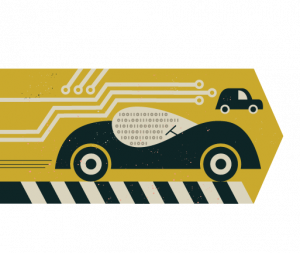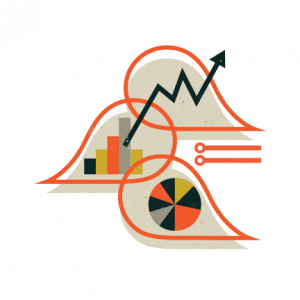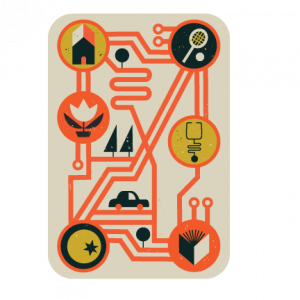
Last March, a chilling dashcam video shot in Tempe, Arizona, made national headlines. Taken at night, the footage showed a woman attempting to cross a four-lane street moments before being struck and killed by an autonomous Uber vehicle. Dressed in black and pushing a bicycle, she seemed to materialize out of nowhere. The camera also captured the car’s backup driver looking down at her lap just before the collision, reportedly streaming an episode of The Voice on her cellphone.
The accident is believed to be the first pedestrian death associated with autonomous-driving technology, and the backlash was swift. State officials ordered Uber to stop testing its autonomous vehicles on public roads in Arizona, which had previously been known for its lenient policies toward autonomous vehicle technology. Boston officials asked self-driving startup nuTonomy to halt its pilot tests in the city, and a handful of companies, including Uber, voluntarily suspended their AV testing nationwide. The chipmaker Nvidia Corporation, which supplied the computing platform for Uber’s autonomous cars, announced it was suspending its self-driving tests globally.
Accidents like the one in Arizona, and the knee-jerk reactions they create, are exactly what civil engineering professor Tak Igusa and his colleagues at Johns Hopkins are working to avoid. If self-driving cars become associated with fatalities and messy crashes, they could trigger what Igusa calls an “autonomous vehicle winter,” stalling the technology’s progress for years to come.
“In conventional vehicles, 90 percent of the fatalities are due to human error,” says Igusa, who is a member of the Center for Systems Science and Engineering. Considering there are more than 37,000 motor vehicle fatalities in the United States each year, he believes the widespread adoption of autonomous vehicles could reap massive public safety benefits. “Autonomous vehicles are not going to do crazy things—driving 30 miles per hour over the speed limit, things like that.”
Unfortunately, self-driving technology still has a long way to go, and unleashing the vehicles on public streets can be a dangerous undertaking. To make the process safer, Igusa has teamed up with researchers at Johns Hopkins’ Bloomberg School of Public Health and the Whiting School’s Department of Applied Mathematics and Statistics to help the industry develop a road map for testing autonomous vehicles.

“This is a perfect marriage of the skills of engineering and public health,” says Johnathon Ehsani, an assistant professor in the School of Public Health, who has been researching AV safety with Igusa since 2017. “You need systems engineering, you need modeling, you need the ability to ingest and make sense of huge amounts of data that may be generated by these vehicles,” he says.
Adds Igusa, “Autonomous vehicles are all about technology, and my role is really to help the people in public health to understand what this technology is about.”
Shaping National Recommendations
 Using publicly available data collected in California, Igusa discovered one of the biggest problems with AV testing is a lack of diversity in the neighborhoods where vehicles are being deployed. Many self-driving car startups are based in Silicon Valley, and they test their software in affluent Northern California communities, where road conditions tend to be better than average.
Using publicly available data collected in California, Igusa discovered one of the biggest problems with AV testing is a lack of diversity in the neighborhoods where vehicles are being deployed. Many self-driving car startups are based in Silicon Valley, and they test their software in affluent Northern California communities, where road conditions tend to be better than average.
Testing in affluent neighborhoods not only skews the data to make AVs appear safer but also keeps self-driving technology out of areas that need it most. “You will only feel comfortable deploying in the same place you tested,” says Igusa, who also is a member of the Center for Injury Research and Policy. The researchers want to ensure the vehicles can provide taxi-style services in low-income areas, where fewer people own cars and access to public transportation is often limited.
Working with the School of Public Health’s extensive network of policymakers, Igusa’s team is developing recommendations to help cities like Boston and Washington, D.C., safely test AVs. They say cities should introduce vehicles in areas that have historically had a low number of traffic accidents and gradually phase in more challenging neighborhoods as the technology improves.
Last year, Igusa and Ehsani presented their findings to the board members and staff of the National Transportation Safety Board, which investigates transportation accidents like the Uber crash in Arizona. They hope their research helps the NTSB shape national recommendations for regulatory bodies and state lawmakers.
“If you buy gas at the gas station, you know it won’t destroy your car because there are government rules in place and organizations that make sure everything is going well. It’s not quite the case with autonomous vehicles,” says Tamás Budavári, an associate professor of applied mathematics and statistics who will lead the project’s data analytics research. “It’s kind of the wild, wild West.”
Igusa and his colleagues believe the key to improving AV safety is to combine brainpower from experts across the fields of public safety, engineering, health, and technology—rather than letting car companies plow ahead without oversight.
“It’s a conflict of interest, really,” explains Budavári, who is known for his work cataloging extremely large astronomical data sets. “That research has to be done by people who are not ‘too close to the fire,’ in a sense.”
Pooling Safety Data
 More than 60 companies are authorized to test self-driving technology with a backup driver on California’s roads, according to state records. In the race to release the first fully self-driving car, these companies are famous for making grandiose claims about the abilities of their technology. Tesla founder Elon Musk tweeted last September that an upcoming software update will allow his cars to drive themselves across the country, while Ford has promised to have a fully autonomous vehicle in operation by 2021.
More than 60 companies are authorized to test self-driving technology with a backup driver on California’s roads, according to state records. In the race to release the first fully self-driving car, these companies are famous for making grandiose claims about the abilities of their technology. Tesla founder Elon Musk tweeted last September that an upcoming software update will allow his cars to drive themselves across the country, while Ford has promised to have a fully autonomous vehicle in operation by 2021.
“Many companies three or four years ago were saying that their vehicles will be fully autonomous and deployed by 2018,” Ehsani says. “If we begin to call out all the manufacturers and CEOs on their undelivered promises, we would have a very long laundry list.”
To help self-driving technology advance more rapidly, Igusa’s group wants to pool safety data from the dozens of companies testing autonomous vehicles across the country, in the hope they will learn from each other’s mistakes.
The researchers received a 2018 Johns Hopkins Discovery Award for their proposal to build an AV consortium that would bring industry leaders and safety experts together to share their knowledge. The consortium would ideally function much like the Commercial Aviation Safety Team, which is credited with reducing the fatality risk for commercial aviation in the United States by 83 percent from 1998 to 2008.
“When one vehicle makes a mistake, the entire fleet can learn from it, but to do that effectively, data need to be shared across the industry,” says Ehsani.
Igusa and Ehsani believe the biggest challenge will be ensuring AVs don’t follow the same path as the air bag. Patented in 1953 and introduced commercially two decades later, early air bag technology was flawed and led to a number of high-profile deaths involving children. The bad press stalled the widespread adoption of air bags until the late 1990s, when federal legislation finally mandated them in all cars and trucks. Considering
motor vehicle fatalities reached record highs in the 1970s, faster air bag adoption likely would have saved countless lives.
“We cannot ignore the carnage that’s happening on the country’s roads right now. For that reason, we want to make sure that the path to widespread, large-scale adoption is as smooth as possible. There will be bumps along the way, but we don’t want there to be a 30-year delay like there was for the air bag,” says Ehsani.
 If the public embraces self-driving vehicles, the net benefit for society could extend well beyond safety, says Igusa. Not only would people have better access to recreational areas and health facilities, but vehicles could also deliver groceries and fresh produce to neighborhoods with few healthy food options. Pairing electric AVs with mass transit could make communities more livable by reducing traffic congestion and cutting pollution from tailpipe emissions.
If the public embraces self-driving vehicles, the net benefit for society could extend well beyond safety, says Igusa. Not only would people have better access to recreational areas and health facilities, but vehicles could also deliver groceries and fresh produce to neighborhoods with few healthy food options. Pairing electric AVs with mass transit could make communities more livable by reducing traffic congestion and cutting pollution from tailpipe emissions.
“From an engineering perspective, this becomes the ultimate design problem, where we bring together research and methods from data science, sociology, injury prevention, policy, and public health, and work with cities to develop deployment strategies,” says Igusa. “Fortunately, at Johns Hopkins, we have deep expertise in all of these areas, and we have a research culture that promotes this type of large-scale, cross-disciplinary activity.”




